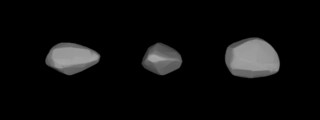Related Research Articles

Aethra is a metallic asteroid and Mars-crosser on an eccentric orbit from the asteroid belt. It measures approximately 40 kilometers in diameter.

229 Adelinda is a large, dark outer main-belt asteroid. It was discovered by Austrian astronomer Johann Palisa on August 22, 1882, in Vienna, and was named after Adelinda, the wife of fellow Austrian astronomer Edmund Weiss.

Germania is a very large main-belt asteroid. It is classified as a B-type asteroid and is probably composed of dark, primitive carbonaceous material.

333 Badenia is a large background asteroid, approximately 72 kilometers in diameter, located the outer region of the asteroid belt. It was discovered on 22 August 1892, by astronomer Max Wolf at the Heidelberg-Königstuhl State Observatory in southwest Germany. The carbonaceous C-type asteroid has a rotation period of 9.9 hours. It was named after the historical Grand Duchy of Baden that existed until 1918, and where the discovering observatory is located. Badenia was the first asteroid to receive a provisional designation.

Desiderata is a very large main-belt asteroid. It is classified as a C-type asteroid and is probably composed of carbonaceous material.

380 Fiducia is a dark and large asteroid, approximately 68 kilometers in diameter, located in the central region of the asteroid belt. It was discovered by French astronomer Auguste Charlois at the Nice Observatory on 8 January 1894. The carbonaceous C-type asteroid has a rotation period of 13.7 hours. It was named "Fiducia", the Latin word for confidence.

388 Charybdis is a very large background asteroid, approximately 125 kilometers in diameter, that is located the outer region of the asteroid belt. It was discovered by French astronomer Auguste Charlois at the Nice Observatory on 7 March 1894. The carbonaceous C-type asteroid has a rotation period of 9.5 hours. It is probably named after Charybdis, a sea monster in Greek mythology.
Liriope is a large Main belt asteroid. It is classified as a C-type asteroid and is probably composed of carbonaceous material.

Vaticana is a large main belt asteroid.

Hippo is a rather large main-belt asteroid. It was discovered by Auguste Charlois on August 25, 1897, in Nice. In the 22nd century, it will come closer than 6,000,000 km (0.04 AU) to the larger asteroids 65 Cybele and 511 Davida.

Galene is a typical main belt asteroid. It was discovered by the French astronomer Auguste Charlois on 27 August 1897 from Nice, and was named after Galene, one of the Nereids of Greek Mythology. This asteroid is orbiting the Sun at a distance of 2.97 AU with a period of 5.12 yr and an eccentricity of 0.12. A computer search suggests it is the most likely parent body of the impactor that generated the temporary cometary activity of 7968 Elst–Pizarro in 1996.
Monachia is an asteroid orbiting within the Flora family in the Main Belt.
Lotis is a large Main belt asteroid. It is classified as a probable C-type asteroid and is likely composed of primitive carbonaceous materials. This object was discovered by Auguste Charlois on 23 November 1897 in Nice.
Hybris is a typical Main belt asteroid.
Pythia is a typical Main belt asteroid.
Carina is a minor planet orbiting the Sun.
701 Oriola is a main belt asteroid. This C-type asteroid shows possible broad absorption which may be explained by either magnesium-rich amorphous pyroxene or crystalline silicate. This likely accounts for the relatively high albedo as an outer-belt asteroid.
9767 Midsomer Norton (1992 EB1) is an outer main-belt asteroid discovered on March 10, 1992, by Duncan Steel at Siding Spring. It is one of very few asteroids located in the 2:1 mean motion resonance with Jupiter.
8373 Stephengould is an outer main-belt binary asteroid discovered on 1 January 1992 by Carolyn S. Shoemaker and Eugene Merle Shoemaker at Palomar Observatory. The asteroid was named after the Harvard paleontologist Stephen Jay Gould. The asteroid has a very high inclination, having the second highest inclination of any of the first 10,000 discovered asteroids in the asteroid belt, after 2938 Hopi.
5201 Ferraz-Mello is an asteroid from the asteroid belt, discovered on 1 December 1983 by Ted Bowell at the Anderson Mesa Station of the Lowell Observatory. It is one of very few Hecuba-gap asteroids located in the 2:1 mean motion resonance with Jupiter.
References
- ↑ Noah Webster (1884) A Practical Dictionary of the English Language
- 1 2 3 4 "431 Nephele (1897 DN)". JPL Small-Body Database . NASA/Jet Propulsion Laboratory. Archived from the original on 16 September 2020. Retrieved 10 May 2016.
- 1 2 Fienga, A.; Avdellidou, C.; Hanuš, J. (February 2020). "Asteroid masses obtained with INPOP planetary ephemerides". Monthly Notices of the Royal Astronomical Society. 492 (1): 589–602. doi: 10.1093/mnras/stz3407 .